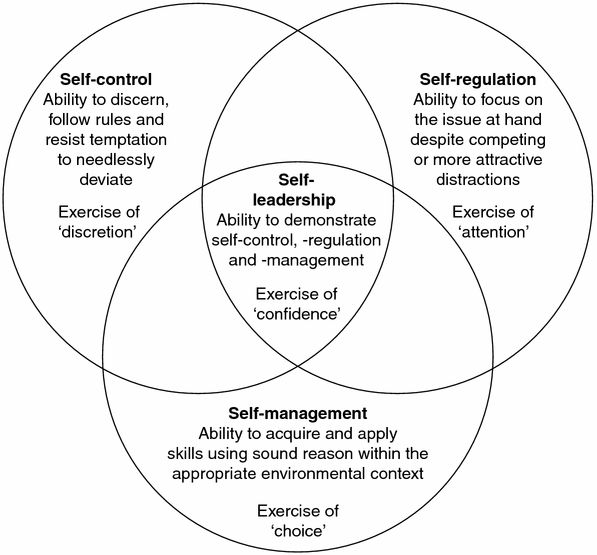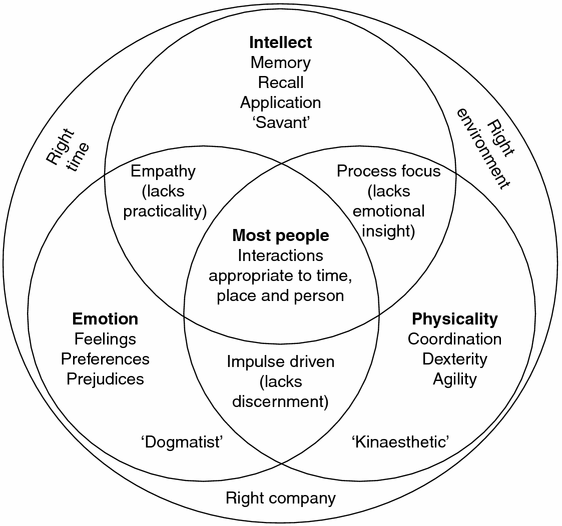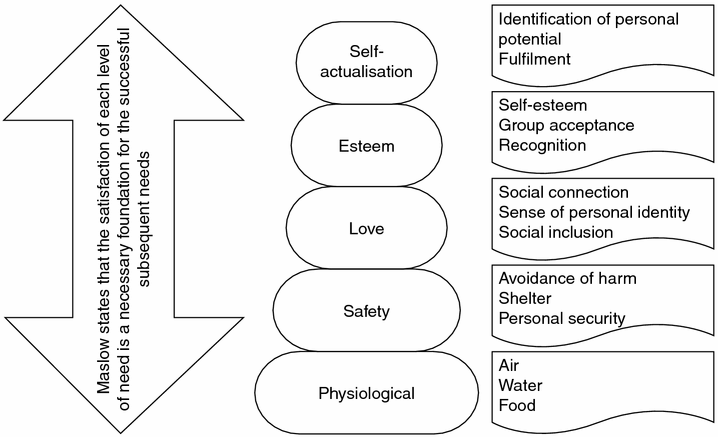Manz (1992, p. 1119) subsequently differentiated self-management from self-leadership, which aligns individuals into teams as contributing to ‘organisational strategic processes’. This is an important link, because the collective contribution of team members adds to departmental achievements, which in turn contribute to organisational outcomes. Self-management, therefore, is not only of concern to the individual but has an impact on organisational performance. Houghton and Neck (2002) conceptualise self-leadership as encompassing self-regulation, self-control and self-management (Figure 4.1) through a process of cognition (or awareness) and motivation.

Figure 4.1 Relationships between self-control, self-regulation, self-management and self-leadership. Adapted from J. D. Houghton & C. P. Neck (2002). The revised self-leadership questionnaire. Journal of Managerial Psychology, 17(8), 672–691. doi: 10.1108/02683940210450484.
If self-management is characterised by making optimal choices, then it would be reasonable to expect that a person adept at self-management will become more effective in and valuable to their workplace (Baum, 1998). This is of paramount interest to organisations. A high-quality organisation is one where every employee knows what is expected of them, has the requisite skills and resources in which to achieve these expectations and is empowered so to do. Breevaart, Bakker and Demerouti (2014) conclude that individuals who are adept at self-management are most likely to be engaged with and in control of their immediate work environment, are secure in their resources, identify challenges and reduce workplace obstacles.
I remember prizing logic above all else and getting frustrated with my fellow nurses who seemed – to me at least – more concerned with the collective sentiment or judgement regarding workplace issues rather than working through the issues systematically. Sometimes the outcome consensus opinion was completely divorced from reality, and it really irked me. On reflection, this was an awesome display and expression of power by my colleagues, often in defiance of ‘logical’ demands made by management that always seemed to require greater productivity for nothing in return. I now realise that the greatest part of my frustration was my inability to communicate my thoughts using language that resonated with my peers or to be able to sense the right time to say the right thing. Clearly, I lacked emotional intelligence.
Intelligence
What role does intelligence play in self-management? Sternberg (2012, p. 503) defines intelligence as the ‘ability to learn from experience, and to adapt to, shape and select environments’ expressed as either the individual changing to suit the circumstances (adaptation), the individual changing the circumstances (shaping) or, when these two strategies fail, opting for a new environment. The ancient Greek philosopher Aristotle described three distinct applications of intelligence: understanding, action (praxis) and production. Aristotle was investigating excellence, whereas Sternberg’s focus is on success (Tigner & Tigner, 2000). This may seem like splitting hairs, except for one important point: excellence can be a subjective perspective, whereas success involves external or objective verification; in other words, it is relational. Sternberg’s theory is by no means universally accepted: Gottfredson (2003) argues against its validity, citing a lack of data and the ‘solid, century long evidentiary base’ associated with psychometric approaches (p. 392).
- Intelligence
The ‘ability to learn from experience, and to adapt to, shape and select environments’ (Sternberg, 2012, p. 503)
Gardner states there is no single general intelligence (Sternberg, 2012) and describes a theory of multiple human intelligences, in that ‘each human being is capable of seven relatively independent forms of information processing’ (Gardner & Hatch, 1989, p. 4). Gardner’s domains include interpersonal, intrapersonal, logical-mathematical, spatial, body kinaesthetic, linguistic and musical intelligences.
Let us consider a simplified model where intelligence could be described using three main themes: intellect (retention, recollection and application of facts), physicality (mastery of the physical body) and emotion (identification, recognition and mastery of emotional responses) (see Figure 4.2). Most of us have varying levels or abilities in relation to these areas, and some aspects of the multiple intelligences theory fit easily: spatial and body kinaesthesia are closely aligned with physical skills, as logical-mathematical and linguistic skills might be with intellect, and inter- and intrapersonal skills with the emotions. Musical skills cross all sectors.

Figure 4.2 Expressions of intelligence
It is not enough to be able to recall facts without being able to apply them. People with dogmatic views at variance with established facts may have a high emotional quotient: fundamentalism of any kind thrives on appeals to emotion, whereas emotion tempered with intellect produces a person who can sympathise and empathise appropriately, and if this is combined with physical skills it will result in non-verbal communication matching the words expressed. A person with intellect and good physical skills but without high emotion might have the capacity to design a highly efficient system, but without due concern or awareness of end user acceptability it is likely to be a failure.
Emotional intelligence is as important as physical or intellectual intelligence (Sternberg, 2012). Just as we need to tailor the words we use to best suit the person with whom we are hoping to communicate, our tone and mode of delivery should also try to anticipate the recipient’s feelings if we are to communicate effectively and efficiently. An added complexity is the issue of context; for example, a particular conversation or action might be thoroughly appropriate in the company of friends at a social gathering and yet completely inappropriate or offensive in a professional or formal setting such as a staff meeting, even when the same people are involved.
Critical thinking
So how might one exercise the choice suggested by self-management? For people in the health professions, critical thinking is an essential skill. The most practical example in the healthcare system is the accurate gathering of a patient’s changing signs and symptoms. A non–critical thinking approach would be to simply record observations and fail to understand their significance, or to treat each of the signs and symptoms independently, with the inherent danger of overlooking underlying conditions or the interplay between them.
- Critical thinking
‘The systematic evaluation or formulation of beliefs or statements, by rational standards’ that forms the basis of problem-solving, decision-making and emotional intelligence (Vaughn & MacDonald, 2010, p. 119)
Critical thinking is a common term but unfortunately there is no unified definition. A content analysis conducted by Geng (2014) identifies over 64 different definitions; however, the most common definitions included the exercise of judgement using reason. A particularly succinct definition is provided by Toplak, West and Stanovich (2014, p. 1039), who state that critical thinkers are people who ‘decouple their prior opinions from the evaluation of evidence and arguments and…consider evidence in opposition to their own view’. A critical thinker never accepts things at face value and always seeks further information and validation. A critical thinking approach involves considering all the factors, identifying and exploring possibilities, weighing up probabilities, arriving at a considered conclusion and being prepared to alter one’s viewpoint on further investigation. More information on critical thinking can be found in chapter 17.
Motivation
So far, we have explored the concepts related to intelligence, the gathering and processing of information, and what we may do as a result. It is timely to think about why we might choose to do certain things. Perhaps the most commonly known model of human motivation is Abraham Maslow’s (1943) hierarchy (see Figure 4.3), which states motivation is driven by needs. Maslow stressed that the hierarchy is not linear, that there is fluidity between the levels.

Figure 4.3 Maslow’s hierarchy of human needs. Adapted from A. H. Maslow (1943). A theory of human motivation. Psychological Review, 50(4), 394–395. doi: 10.1037/H0054346.
The most basic needs are those related to biology, such as air, food and water; without these, a person could not survive. The next level of need relates to safety, so that potential harms associated with the natural environment (shelter from extremes of cold and heat, animal predation, avoidable disease) and with societal factors (violence arising from lawlessness, social inequity) are either avoided or minimised. Maslow (1943) suggests that after this, the next emergent need is for love – stressing that ‘love is not synonymous with sex’, as it is also a physiological need – and that love must be reciprocated. Esteem, the next level, relates to the capacity of people to enjoy not only a good opinion of themselves but also the regard of their peers. At the apex is the need termed self-actualisation, relating to the identification of personal potential and (hopefully) personal achievement. Maslow states that self-actualisation is dependent upon satisfying prior needs, and that there will be variance in the perception of different individuals: some needs may be conscious, while others are unconscious.
Maslow (1943) acknowledges that needs influence behaviours, and that goals therefore become ‘the [centring] principle in motivation theory’ (p. 391), suggesting that needs generate aspirations, which are measured by and have meaning for the individual. The conclusion one may draw from this is that there are environmental factors required to achieve self-actualisation. It is unreasonable to expect a person to achieve optimal self-management in a workplace where there are, for example, physical hazards, discord, disunity or poor or ill-defined work practices. Individual self-management is not a solution for poor organisation design or a failure of general supervision or management.
Social learning
It is clear that learning from academic or evidentiary sources is valuable and necessary, but one often hears about the ‘theory–practice gap’ – that someone may have good conceptual understanding but fail to implement their knowledge in any practical manner. Social learning theory suggests that learning occurs not solely by memorisation of facts and figures but also by an individual modelling their behaviours on those of people admired for their skills and expertise – that is, learning by observing and doing (Bandura, 1971; Baum, 1998; Boyce, 2011; Brauer & Tittle, 2012; Markham & Markham, 1995).
Bandura (1971) acknowledges the four key components of learning – attention, retention, reproduction and reinforcement – but says that the defining difference is that most learning, social or otherwise, occurs by observing others, and that positive or persuasive reinforcement occurs when the model exhibits ‘status, prestige and power’ (p. 18). It follows that those with status, prestige and power are more likely to influence others.
Aspirations and goals
Most people have a general idea of what they want to achieve in life. Some approach their aspirations with single-mindedness and determination at the expense of other factors in their life. They have clearly defined plans and can describe to anyone exactly what they want to achieve and, perhaps more importantly, how they are going to do it and how they will know they have achieved it.
- Aspiration
Something we would like to achieve
Stay updated, free articles. Join our Telegram channel

Full access? Get Clinical Tree


